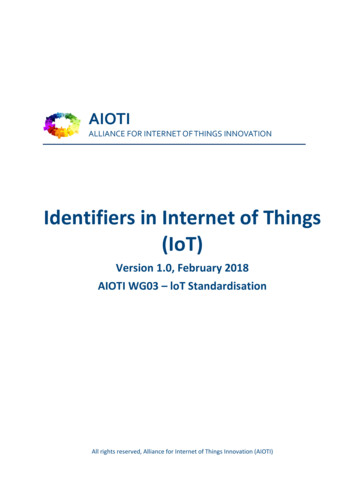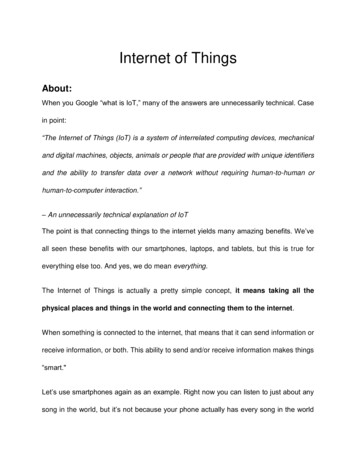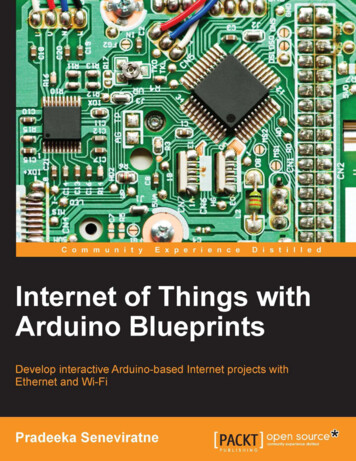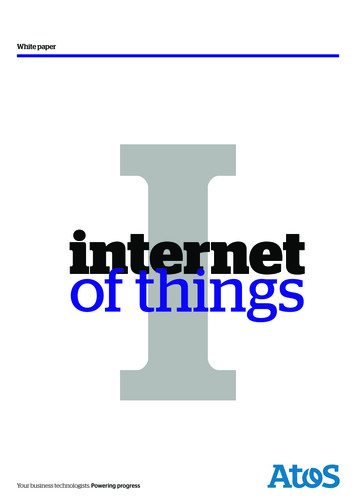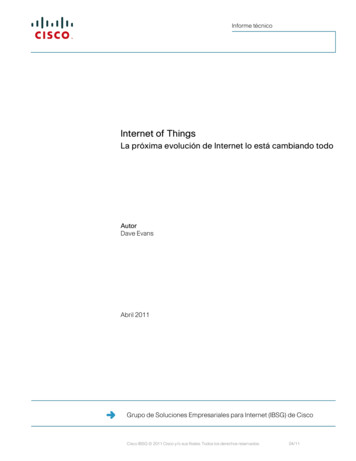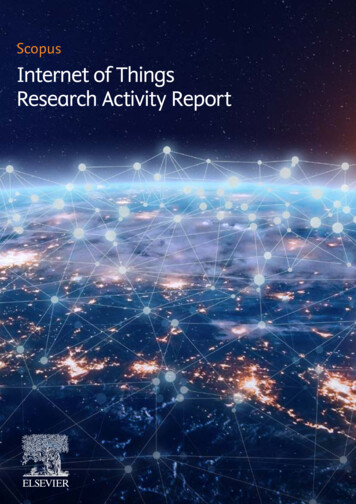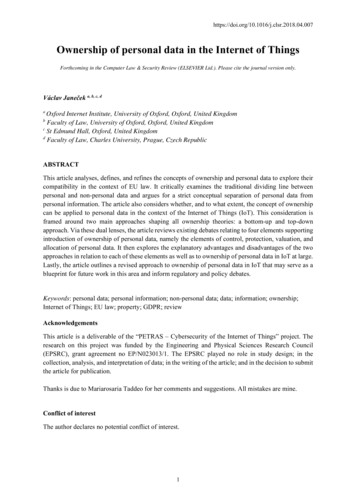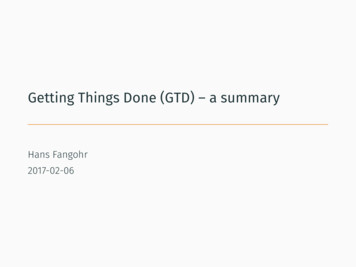
Transcription
Internet of Things ApplicationsAIOTI WG01 – IERCRelease 1.0th15 October 20152015
IntroductionThe Internet of Things (IoT) value chains are today fragmented and many companies havedeveloped innovative strategies and technology offerings, which have given rise to a number ofsubmarkets such as M2M application platforms, M2M network security, connected deviceplatforms, service cloud platforms, and industry specific vertical IoT platforms. In this context,the industry has challenges in defining the IoT business cases, the industry’s IoT roadmap, IoTvalue chain analysis, deployment case studies, the vertical market ecosystem, vendorservice/product strategies, strategic recommendations and comprehensive forecasts for the IoTmarket from 2015 until 2020, including an individual assessment of the submarkets.IoT technology and applications are likely to be major drivers of investment and innovation inthe communications sector, over the next years, delivering significant benefits to citizens,consumers and industrial end-users. These will lead to the introduction of many new andinnovative services. It will allow data to be transmitted between many different types of devices,improving the safety of transportation, reducing the consumption of energy and improving ourhealth.The IoT technology is evolving and demonstrating the features in various applications requirethe integration of the highest, most generalized layer of intelligence and user interface that tiestogether connected devices and web services using interoperable platforms that deliver thefunctionality required by the end-users.The IoT is bridging the virtual world with the physical world and the mobile networks need toscale to match the demands of 25-50 billion things while the processing capabilities requireaddressing the information provided by the "digital shadow" of these real things. In this context,there is a need to focus on the developments in the virtual world and the physical world forsolving the challenges of IoT applications. In the virtual world, network virtualization, softwaredefined hardware/networks, device management platforms, edge computing and dataprocessing/analytics are developing fast and urgency to be endeavoured as enabling technologiesfor IoT. The research and innovation in nanoelectronics, semiconductor, sensors/actuatorstechnology, and cyber-physical systems are essential for the successful deployment of IoTapplications.In the physical world, the new wireless technologies for body/personal, home, local,neighbourhood and wide area networks all promise to deliver better economies of scale in termsof cost, energy and number of connections.Bringing the IoT to life requires a comprehensive systems approach, inclusive of intelligentprocessing and sensing/actuating technology, connectivity (distributed intelligent gateways,communication cells, etc.), software and services, along with an ecosystem to address the smartenvironments applications.In the last few years the European Commission’s direct investment reached more than 100 Mill.Euro in the Internet of Things field and this has to be reflected by disseminating products andservices developed through the EU FP7 projects and combining them with new products andservices developed by industry.AIOTI - Restricted2
Businesses and other organisations could benefit from new and improved IoT technologiesdeveloped in these projects. The increased productivity and enhanced ability of theseorganisations to offer new goods and services in turn supports the increase of Europe’s outputand GDP and the benefits from increased knowledge to enhance policy making and achieveits desired out- comes. These investments need to be mirrored in IoT commercial products andservices which are developed with the help of EU funding, through research and developmentcontracts, patents, use of EU funded facilities, technical assistance from EU, or data from EUprojects research.The IERC - IoT European Research Cluster – is bringing together EU funded projects with theaim of defining a common vision of IoT technology and addressing European researchchallenges. The rationale is to target the large potential for IoT-based capabilities;coordinate/encourage the convergence of ongoing work on to tackle the most important issues;and build a broadly based consensus for the realization and deployment of the IoT technology inEurope in order to keep the leadership and the competitive advantage on the world market.The European Commission has adopted on May 2015 the Digital Single Market strategy and hasopened the door for large-scale proposals to improve the future of industrial development. In thiscontext, the future activities can mobilise the important research work delivered by the IERCprojects in terms of IoT technology and societal analysis, and apply it in the market and in theEU policies. The launch of the Alliance for IoT Innovation (AIOTI) in order to develop andsupport the dialogue and interaction among the various IoT players should be seen as a signal inthis direction.The IoT research, development and deployment efforts will be fruitless if the EC and theMember States fail to continue to invest in the enabling technologies and factors that are requiredto accelerate the IoT that takes various implementation forms such as Industrial Internet ofThings (IIoT) or Internet of Everything (IoE). The technology behind the IoT has to be combinedwith a number of larger and broader social, economic and political factors if Europe is to makethe most of their productive and innovative potential. The problem for the IoT technology andapplication stakeholders is that these factors are complex, and often not under the control of theprivate sector.EC and the Member States will need to make an even bigger investment in digital infrastructureif they are to support and facilitate the IoT deployment, as its success is critically dependent onthe presence of robust infrastructures (anybody, anytime, anywhere, any device, any network andany business), such as ubiquitous connectivity, gateways and edge devices.This will allow eliminating the "digital divide" and creating the basis for the implementation ofthe Digital Single Market.AIOTI - Restricted3
Executive SummaryThe IoT technological advancements and convergence within the IoT related technologies shapedynamically the emergence of new business models and IoT ecosystems. These ecosystemscomprise of stakeholders representing the IoT application value-chain: components, chips,sensors, actuators, embedded processing and communication, system integration, middleware,architecture design, software, security, service provision, usage, test, etc. This new model allowsintegrating the future generations of applications, devices, embedded systems and networktechnologies and other evolving ICT advances, based on open platforms and standardisedidentifiers, protocols and architectures.In this context, the deployment of IoT Large Scale Pilots (LSPs), to promote the marketemergence of IoT and overcome the fragmentation of vertically oriented closed systems,architectures and application areas is the next important step in the IoT development. The LSPscan address the challenges in different application areas by bringing together the technologysupply and the application demand sides in real-life settings to demonstrate and validate the IoTtechnology in real environments.While human social and economic activities continue to gravitate towards urban centres, SmartCities deploy digital and telecommunication technologies to increase administration efficiencyand improve the quality of life of their inhabitants.Cross-domain challenges in public safety, mobility, lighting and energy efficiency can beaddressed by user-centric ecosystems of interoperable vertical sub-systems. The integration andcompatibility of sensors and actuators of connected sub-systems that are often complementary inthe public space, in turn, stimulates the development of novel data-driven value-addedapplication domain services. Due to their high density and ubiquitous nature, connected systemsoffer the prospect of evolving into platforms acquiring domain-level contextual information anddelivering application management functions to diverse domains' stakeholders.The LSPs need to address challenges in the fields of standardization, cyber-security, open datagovernance and privacy, and validate the novel business models underlying the servicesprovisioned by future domain infrastructures. These IoT LSPs have to address technologychallenges across the industrial sector verticals and go beyond the M2M, IoT verticalapplications developed in the recent years, in order to break the silos and to evaluate the realimpact of IoT technology across industrial domains. The definition of themes need to have abroader perspective and go beyond the narrower use cases proposed until now since in the futurethat cross-vertical collaboration and integration will be among the primary benefits of IoT.This document provide an overview of the research and developments results of the IERCprojects and the key elements related to the IoT technology developments and deployments forthe domains covered by the future IoT LSPs. The report provides information about IoTtechnological and deployment challenges, findings, and recommendations for action for the useof the results in the new LSPs.AIOTI - Restricted4
Table of Contents1MISSION STATEMENT. 61.1AIOTI WG01 OBJECTIVES . 71.1.1 Vision . 71.1.2 Objectives . 81.1.3 Research and Innovation Challenges . 92INTEROPERABILITY . 123IOT POLICY ISSUES . 134IOT STANDARDISATION . 164.15EXAMPLES OF MAPPING TO STANDARDISED COMMUNICATION PROTOCOLS TO APPLICATIONS . 17IOT APPLICATIONS . 205.15.25.35.45.55.65.75.85.95.10HEALTHCARE AND WELLNESS . 20LIVING ENVIRONMENTS . 22BUILDINGS . 23ENERGY. 25FARMING AND FOOD SECURITY. 27WEARABLES . 29CITIES . 29MOBILITY . 33ENVIRONMENT . 37MANUFACTURING . 386RECOMMENDATIONS . 407REFERENCES . 40AIOTI - Restricted5
1Mission Statement"Imagination is not only the uniquely human capacity to envision that which is not, and, therefore, thefoundation of all invention and innovation. In its arguably most transformative and revelatory capacity, itis the power that enables us to empathize with humans whose experiences we have never shared."J.K. RowlingIoT is a concept and a paradigm that considers pervasive presence in the environment of a variety ofthings/objects that through wireless and wired connections and unique addressing schemes are able tointeract with each other and cooperate with other things/objects to create new applications/services andreach common goals.The IoT is the network of physic al objects that contain embedded technology to communicate and senseor interact with their internal states or the external environment. The confluence of efficient wirelessprotocols, improved sensors, cheaper processors, and a bevy of start-ups and established companiesdeveloping the necessary management and application software, has finally made the concept of the IoTmainstream.The IoT makes use of synergies that are generated by the convergence of Consumer, Business andIndustrial Internet Consumer, Business and Industrial Internet. The convergence creates the open, globalnetwork connecting people, data, and things. This convergence leverages the cloud to connect intelligentthings that sense and transmit a broad array of data, helping creating services that would not be obviouswithout this level of connectivity and analytical intelligence. The use of platforms is being driven bytransformative technologies such as cloud, things, and mobile.The dynamics surrounding emerging IoT applications are very complex and issues such as enablement,network connectivity, systems integration, value-added services, and other management functions are allneeds that generally must be addressed when the end-users seek to connect intelligent edge devices intocomplex IoT applications. From the end-user standpoint, open alliances between different stakeholders inthe IoT value chain are the best available means to address these complexities.The IoT LSPs require combining technologies from multiple domains and packaging them into a cohesiveuser driven experience that will help ensure all of the IoT application value that is being captured is beingused and monetized.The development of enabling technologies such as nanoelectronics, communications, sensors, smartphones, embedded systems, cloud networking, network virtualization and software will be essential toprovide to things the capability to be connected all the time everywhere. This will also support importantfuture IoT product innovations affecting many different industrial sectors.Some of these technologies such as embedded or cyber-physical systems form the edges of the Internet ofThings bridging the gap between cyber space and the physical world of real things, and are crucial inenabling the Internet of Things to deliver on its vision and become part of bigger systems in a world of“systems of systems”.The IERC definition states that IoT is “A dynamic global network infrastructure with self-configuringcapabilities based on standard and interoperable communication protocols where physical and virtual“things” have identities, physical attributes, and virtual personalities and use intelligent interfaces, andare seamlessly integrated into the information network.”.The major objectives for IoT are the creation of smart environments/spaces and self-aware things (i.e.smart transport, products, cities, buildings, rural areas, energy, health, living, etc.) for climate, food,energy, mobility, digital society and health applications.One challenge is receiving the data from the things in an interoperable format and in creating systems thatbreak vertical silos and harvest the data across domains, thus unleashing truly useful IoT applications thatAIOTI - Restricted6
are user centred, context aware and create new services by communication across the verticals.These exchange and processing capabilities are part of the concept of the Internet of Things (IoT) appliedto applications such as Internet of Energy (IoE), Internet of Lighting (IoL), Internet of Buildings (IoB)and Internet of Vehicles (IoV) in the City context.The aim is to create ecosystems of state-of-the-art, viable, technologies that apply the IoT, IoE and IoVconcepts to increase the efficiency of the application domain by enabling unobtrusive, adaptable andhighly usable services at the network-edge, gateway and cloud levels.In this context, the IoT LSPs activities can mobilise the important research work delivered by the IERC interms of IoT technology and societal analysis, and apply it in the market and in the EU policies.1.11.1.1AIOTI WG01 ObjectivesVisionThe IERC is bringing together EU funded projects with the aim of defining a common vision of IoTtechnology and addressing European research challenges. The rationale is to target the large potential forIoT-based capabilities and promote the use of the results from the existing projects to encourage theconvergence of ongoing work to tackle the most important deployment issues and the transfer of researchand knowledge to products and services and apply these in real IoT applications.IoT is a new revolution of the Internet. Things make themselves recognizable and they obtain intelligencethanks to the fact that they can communicate information about themselves and they can accessinformation that has been aggregated by other things.The technological trend is a move from systems where there are multiple users/people per device, peoplein control loop of the system, and the system providing the ability for people to interact with people. TheIoT brings a new paradigm where there are multiple devices per user; the devices are things that areconnected and communicating with other things. The interaction will be with a heterogeneous continuumof users, things and real physical events (e.g., move left/right/up/down, changehumidity/temperature/light/sound, etc.) and the Internet is the common convergence connectivitycapability, replacing the previous independent systems.Figure 1.1: IERC Vison for IoT Integrated Environment and EcosystemsThe vison of the IERC is bringing together EU-funded projects with the aim of defining a commonstrategy of IoT technology, addressing European research challenges and supporting all the key phases inthe research, innovation, development, deployment and adoption of new IoT technologies andAIOTI - Restricted7
applications.1.1.2ObjectivesThe objectives of the IERC related to the IoT LSPs is to provide the information related to the importantresearch work and results delivered by the IERC projects in terms of IoT technology and societal analysis,and apply it in the IoT LSPs and further into the market applications and in the EU policies. The finalgoal is to test and develop innovative and interoperable IoT solutions in areas of industrial and publicinterest.The IERC objectives are addressed as an IoT continuum of research, innovation, development,deployment and adoption as presented in Figure 1.2.Figure 1.2: IoT Continuum – Research, Innovation, DeploymentThe objectives are considering the use of the important research work and results delivered by the IERCprojects to provide scalable proof-of-concepts so that IoT technology and applications can bemainstreamed in the industrial and public processes, products and services. IoT-based innovationsemerged from the previous projects combined with the new ideas put forward in the IoT LSPs allow totest in real settings, demonstrate the genuine value, and prepare for the wider IoT adoption.The Internet of Things European landscape is evolving and the IERC will focus on the creation of Internetof Things ecosystems in the context of smart environments and applications with links to other disciplinesthat provide the enabling technologies for IoT applications. Emphasis will be on on stronger combinationof IoT with nanoelectronics, cyber-physical systems (CPS), smart system integration, edge computing,future Internet, network technologies, analytic, and new areas like nanotechnology, cognitive science,biotechnology, while supporting the policy and social dialogue is laying the foundation for the “digitalsociety”.IERC will take measures for supporting the development of ecosystems around the platforms addressedby the new projects under the IoT connected platforms programme emerged from the ICT30 Call andprovide input to the future IoT LSPs.The IERC is actively involved in the AIOTI that was initiated in cooperation with the EuropeanCommission in order to develop and support the dialogue and interaction among the various IoT players.The overall goal of the establishment of the AlOTI is the creation of a dynamic European IoT ecosystemto unleash the potentials of the IoT.AIOTI - Restricted8
1.1.3Research and Innovation ChallengesThe new ICT technological developments will boost nanoelectronics, edge computing, connectivity,architectures and platforms, while IoT will become a strategic element to enable and drive the DigitalSingle Market (DSM) through new products and services. IoT is an emerging and disruptive technologythat integrates devices, data, connections, processes and people and will affect the technological andeconomic development in the next years.The traditional distinction between network and device is starting to blur as the functionalities of the twobecome indistinguishable. Shifting the focus from the IoT network to the devices costs less, scales moregracefully, and leads to immediate revenues.Figure 1.3: Internet of Things EnvironmentThe systemic nature of innovation requires the need for coordination stakeholders, systems and servicesin interaction-intensive environments with a permanent and seamless mix of online and real-worldexperiences and offerings, as the IoT will consist of countless cyber-physical systems. The overlay ofvirtual and physical will be enabled by layered and augmented reality interfaces for interconnected things,smartphones, wearables, industrial equipment, which will exchange continuous data via edgesensor/actuator networks and context-aware applications using ubiquitous connectivity and computing byintegrating technologies such as cloud edge cloud/fog and mobile. In this context, the IoT applicationswill have real time access to intelligence about virtual and physical processes and events by open, linkedand smart data.The future IoT developments will address highly distributed IoT applications involving a high degree ofdistribution, and processing at the edge of the network by using platforms that that provide compute,storage, and networking services between edge devices and computing data centres. These platforms willsupport emerging IoT applications that demand real-time latency (i.e. mobility/transport, industrialautomation, safety critical wireless sensor networks, etc.). These developments will bring new challengesas presented in Figure 1.4.The IoT value will come from the combination of edge computing and data centre computing consideringthe optimal business model, the right location, right timing, and efficient use of available networkresources and bandwidth.The IoT architecture, like the Internet, will grow in evolutionary fashion from a variety of separatecontributions and there are many current efforts regarding architecture models under development. TheIERC was supported and encouraged the projects in the Cluster to use a common approach that is basedon the Architectural Reference Model from the EU IoT-A project in order to assure interoperabilityamong different implementations considering that in the future it is likely that several referenceAIOTI - Restricted9
architectures will co-exist in the Internet of Things. The challenges that the IERC considers for the IoTarchitecture are the complexity and cooperative work for developing, adopting and maintaining aneffective cross-industry technology reference architecture that will allow for true interoperability and easeof deployment.Figure 1.4: IoT Future ChallengesThe IERC will work for providing the framework for the convergence of the IoT architecture approachesconsidering the vertical definition of the architectural layers end to end security and horizontalinteroperability. IoT technology is deployed globally, and supporting the activities for common unifiedreference architecture would increase the coherence between various IoT platforms. A commonarchitectural approach will require focusing on the reference model, specifications, requirements, featuresand functionality. In particular this issue would be important in preparation of the future IoT LSPs,although time schedule might be difficult to synchronize.The IERC will cooperate with AIOTI WG03 to imitate a discussion with the SDOs working groupsaddressing the IoT reference architecture in order to provide a common framework convergence towardsa common approach.The horizontal character of the IoT requires the creation of IoT ecosystems as a pre-requisite for thedevelopment of innovation and IoT applications take up. In order to address the totality of interrelatedtechnologies the IoT technology ecosystem is essential and the enabling technologies will have differentroles such as components, products/applications, and support and infrastructure in these ecosystems. Thetechnologies will interact through these roles and impact the IoT technological deployment.IoT ecosystems offer solutions comprising a large system beyond a platform and solve importanttechnical challenges in the different verticals and across verticals. These IoT technology ecosystems areinstrumental for the deployment of large pilots and can easily be connected to or build upon the core IoTsolutions for different applications in order to expand the system of use and allow new and evenunanticipated IoT end uses.The IoT requires alliances between multiple sectors and stakeholders to cover an increasingly complexvalue chain and open platforms that can integrate many different types of equipment and applications.The challenges are related to the complexity of services and solution delivery ecosystems. These IoTecosystems are part of the technology disruption that could cause shifts across value chains whererevenue and profits are generated. The emerging IoT ecosystems can evolve and contribute to the IoTLSPs and the IoT technology and applications can be combined with the activities driven by end-usersand citizens, and involving existing and new communities at an early stage.AIOTI - Restricted10
IoT applications have developed on multiple architectures, standards and platforms, resulting in a highlyfragmented IoT landscape. The existing IoT applications show a multitude of solutions for edge deviceswith small installed bases that produce siloed data to which marketers have limited access. The verticalsilos and fragmented Smart X landscape is not yet well aligned with the larger IT infrastructure andnetwork services players.The IoT technology will face a new challenge due to heterogeneous integration of various technologiesthat requires the technology convergence at various levels. This is mainly due to the anticipation andexpectation of new IoT products, services and systems innovation modes that are not widely adoptedtoday. The increased number of IoT edge devices and their "digital shadows" logically multiplies the totalnumber of application infrastructure endpoints that consume or produce data and events, and which in"real-time" need to interoperate with other applications, business processes and operational businessintelligence systems as presented in Figure 1.5.IoT applications are using at the edge of the network sensors collecting data on a computing andcommunicating device and actuators to perform specific tasks controlled by these devices. A wave ofinnovation and experimentation is needed in developing these nodes by determine what sensors measure,actuators act, communication/computing is performed, how the nodes are embedded, packages, how theylook like, and how much they cost.The IoT edge devices will increase the overall complexity of distributed business processes, the volumeof messages and data flowing across all ICT assets, and drive more demand for "real-time"interoperability with other applications and systems Data security and data protection is a challenge in theintegration process for various IoT applications. The developed integrated software defined networking(SDN) and network virtualisation functions (NVF) features for IoT platforms require to implement eventtriggers which can isolate network components and operations in order to provide real-time security.The rise of recurring revenue business models and the IoT could transform a wide range of industries,creating new opportunities for customer engagement and revenue growth. The challenge for IoTtechnology providers, and the stockholders in the IoT ecosystem, is to create value that will convinceindividuals or business to use it and pay for it. Today the companies are using va
The Internet of Things (IoT) value chains are today fragmented and many companies have developed innovative strategies and technology offerings, which have given rise to a number of submarkets such as M2M application platforms, M2M network security, connected device platforms, service cloud platforms, and industry specific vertical IoT .

